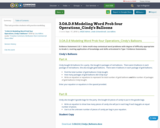
This task provides students with practice modeling.
- Subject:
- Education
- Mathematics
- Material Type:
- Activity/Lab
- Assessment
- Homework/Assignment
- Author:
- Linda Schoenbrodt
- Lisa Adkins
- MSDE Admin
- Date Added:
- 02/16/2022

This task provides students with practice modeling.

This is a modified version of the SCRIPT training slides from 2021-22 that is designed for facilitation over three 2-hour virtual sessions.
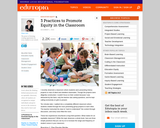
Learn about the thinking behind three equitable practices in classroom where all students are recognized as unique individuals, have equity in voice, and given access to the resources they need to learn.
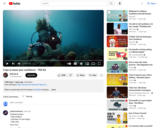
View full lesson: http://ed.ted.com/lessons/3-tips-to-boost-your-confidence-ted-edMade in partnership with the Always #LikeAGirl campaign.When faced with a b...
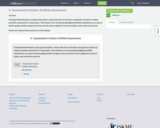
Principal Matt Renwick, principal and author, works with the art teacher and grade 5 teacher to utilize portfolio assessment in classrooms. The teachers are incorporating digital portfolio assessment as a way to better gauge student progress and success for more subjective areas of study, such as literacy and art. Read more about these practices in the module.

Lessons on this topic teach students about the effects of digital drama, cyberbullying, and hate speech on both themselves and their larger communities. Students explore how individual actions -- negative and positive, intentional and unintentional -- can affect their peers and others. They're encouraged to take the active role of upstander and build positive, supportive online communities, and they will learn how to cultivate empathy, compassion, and courage to combat negative interactions online.
Even though young kids aren't online yet, early lessons on cyberbullying can easily connect to the social and emotional skill-building that happens during early elementary school. By focusing on empathy and compassion, conversations about cyberbullying can give young kids a foundation for future positive online experiences. For older kids, teachers can help students reflect on their own behavior and build strategies for how to respond when they witness cyberbullying.
Introduce cyberbullying in your classroom with one of these four essential lessons, each of which can be modified for use in slightly older or younger grades:
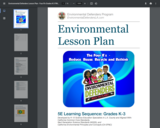
This resource is a lesson plan focusing on teaching the 4 R's - Reduce, Reuse, Recycle, Rethink. This lesson aims to demonstrate how an understanding of these 4 R's can play an important role in conservation efforts. Also that there many different things everyone can do to incorporate the 4 R's into your life. This lesson plan includes the objectives, standards, teacher background information, time guide, material list, literacy books, vocabulary, directions, and resouces.
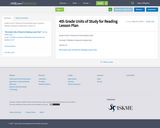
Grade 4 Unit 5: Historical Fiction Book Clubs
Concept 3: Readers interpret complex text.
Session 12

Photo showing 50% intake of food on a plate.
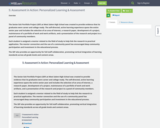
The Senior Exit Portfolio Project (SEP) at West Salem High School was created to provide evidence that its graduates were career and college ready. The self-directed, active learning experience spans the entire senior year and includes the selection of an area of interest, a research paper, development of a project, maintenance of a portfolio of work and work artifacts, and a presentation of the research and project to a panel of community members. Each student is assigned a mentor related to the field of study to help link the research to practical application. The mentor connection and the use of a community panel has encouraged deep community participation and investment in the educational process. The SEP also provides an opportunity for full staff collaboration, promoting vertical integration of learning standards across all grade levels and content areas.
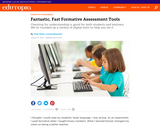
This short blog post provides five examples of tools to use for formative assessment.
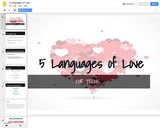
Students will learn about the 5 Languages of Love and the definitions of all of them. They will then "guess" which one is their primary language. After "guessing" they will take a self-assessment and find out what their primary love language is. We will then discuss what they can do with this information.
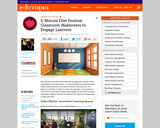
Explore these resources to help answer the questions: How important is environment to learning? And what small changes can you make in seating, organization, lighting, and decor to build your own space into a better place to teach and learn?
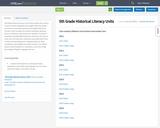
5th Grade Historical Literacy Curriculum outlines the content of social-studies integrated units taught within the readers' and writers' workshop framework and taught daily for 90 minutes. Each six week unit contains standards, teaching points, vocabulary, and assessments. Readers' and writers' workshop naturally differentiates for all learners. By June of 2020, each unit will have a slide deck associated with it that contains the teaching points, integrated grammar work, vocabulary, and strategies for partner practice. Our district places careful emphasis on vocabulary, as we have a high percentage of English Language Learners.
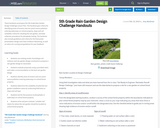
These handouts accompany the 5th Grade Rain Garden Design Challenge Lesson Plan. The handouts give criteria for identifying areas of erosion and non-point source pollution entering waterways on school property, slope and soil suitability criteria for situating the rain garden, and data collection procedures for phosphate testing. The handouts also include guidelines and criteria for the final poster presentation design and Claim-Evidence-Reasoning, as well as rubrics for scoring and guidelines for peer feedback.
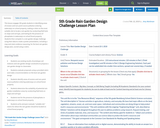
This lesson engages 5th grade students in identifying areas of erosion and non-point source pollution entering waterways on school property, making a claim on the most suitable site to locate a rain garden by conducting field tests on slope and soil type, and testing
for the presence of phosphates in waterways on school forest property. Students then compete in a rain garden design challenge using their data to create a poster presentation, including a map and claim evidence reasoning, for the best rain garden design plan, scored using a rubric.
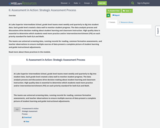
At Lake Superior Intermediate School, grade level teams meet weekly and quarterly to dig into student data. Each grade level created a data wall to monitor student progress. The data analysis process and discussions drive decision making about student learning and classroom instruction. High quality data is essential to determine which students need more practice and/or intervention/enrichment (PIE) on each priority standard for both ELA and Math. The teams use universal screening data, running records for reading, common formative assessments, and teacher observations to ensure multiple sources of data present a complete picture of student learning and guide instructional adjustments.Read more about these practices in the module.

This resource is for teachers who want a lesson on environmental impacts on the climate due to humans for middle school, high school, and college grades. There are various activities, readings, and videos for each of the different schools.
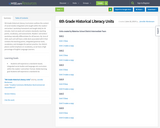
5th Grade Historical Literacy Curriculum outlines the content of social-studies integrated units taught within the readers' and writers' workshop framework and taught daily for 90 minutes. Each six week unit contains standards, teaching points, vocabulary, and assessments. Readers' and writers' workshop naturally differentiates for all learners. By June of 2020, each unit will have a slide deck associated with it that contains the teaching points, integrated grammar work, vocabulary, and strategies for partner practice. Our district places careful emphasis on vocabulary, as we have a high percentage of English Language Learners.
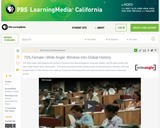
This Wide Angle video features the women of Rwanda who have emerged as outspoken leaders and the great strides they have made toward rights and equality.